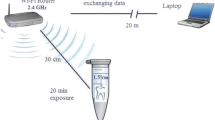Abstract
Objectives
We have investigated the effects of X-rays and magnetic resonance imaging (MRI) on the release of mercury from dental amalgam into artificial saliva.
Methods
A commercial brand of amalgam capsules was used, and the capsules were molded into discs (diameter 3 mm, thickness 1 mm) in plexiglas molds before treatment. The samples were divided into three groups. The first group was exposed to X-rays, the second group was exposed to MRI in a soft tissue-equivalent material, and the third group contained an equal number of samples as a control group. All samples were stored in artificial saliva for 1, 2, or 24 h. Mercury analyses were performed with a cold vapor atomic absorption spectrometer. The results were analyzed by two-way repeated-measures analysis of variance with the Bonferroni correction as a post hoc test at the 95 % confidence level.
Results
A significant increase in mercury was detected in the X-ray-exposed group versus the control group (mean values 5.79 vs. 3.84 ppb, respectively; p ≤ 0.05). However, no significant difference in mercury dissolution was found between the MRI-exposed group and the control group (mean values: 4.51 vs. 4.30 ppb).
Conclusions
Mercury release increased after exposure to X-rays, but no change was detected after exposure to MRI.
Similar content being viewed by others
Explore related subjects
Discover the latest articles and news from researchers in related subjects, suggested using machine learning.References
Phillips RW. Skinner’s science of dental materials, 9th edn. Philadelphia: Saunders; 1991.
Campus G, Garcia-Godoy F, Gaspa L, Panzanelli A, Piu PC, Micera G, et al. Dependence of kinetic variables in the short-term release of Hg2+, Cu2+ and Zn2+ ions into synthetic saliva from an high-copper dental amalgam. J Mater Sci Mater Med. 2007;18:1521–7.
Roberts HW, Charlton DG. The release of mercury from amalgam restorations and its health effects: a review. Oper Dent. 2009;34:605–14.
Pinto OF, Huggins HA. Mercury poisoning in America. J Int Acad Prev Med. 1976;3:42–58.
McHugh WD. Statements: effects and side-effects of dental restorative materials. Adv Dent Res. 1992;6:139–44.
Eley BM. The future of dental amalgam: a review of the literature. Part 3: mercury exposure from amalgam restorations in dental patients. Br Dent J. 1997;182:333–8.
Uçar Y, Brantley WA. Biocompatibility of dental amalgams. Int J Dent. 2011;2011:981595. doi:10.1155/2011/981595.
Spencer AJ. Dental amalgam and mercury in dentistry. Aust Dent J. 2000;45:224–34.
Fusayama T, Katayori T, Nomoto S. Corrosion of gold and amalgam placed in contact with each other. J Dent Res. 1963;42:1183–97.
[No authors listed]. Dental amalgam: update on safety concerns. ADA Council on Scientific Affairs. J Am Dent Assoc. 1998;129:494–503.
Stadtler P. Dental amalgam I: toxicity. Int J Clin Pharmacol Ther Toxicol. 1991;29:161.
Svensson BG, Schulz A, Nisson A, Akesson I, Akesson B, Skerfving S. Fish as a source of exposure to mercury and selenium. Sci Total Environ. 1992;126:61–74.
World Health Organization (WHO). Environmental health criteria 101: Methylmercury International Program on Chemical Safety. Geneva: World Health Organization; 1990.
Barregård L, Sällsten G, Järvholm B. People with high mercury uptake from their own dental amalgam filling. Occup Environ Med. 1995;52:124–8.
World Health Organization. Guidance for identifying populations at risk from mercury exposure. Geneva: World Health Organization; 2008.
Marek M. The release of mercury from dental amalgam: the mechanism and in vitro testing. J Dent Res. 1990;69:1167–74.
Marek M. The effect of tin on the corrosion behavior of the Ag-Hg phase of dental amalgam and dissolution of mercury. J Dent Res. 1990;69:1786–90.
Okabe T, Ferracane J, Cooper C, Matsumoto H, Wagner M. Dissolution of mercury from amalgam into saline solution. J Dent Res. 1987;66:33–7.
Ferracane JL, Mafiana P, Cooper C, Okabe T. Time-dependent dissolution of amalgams into saline solution. J Dent Res. 1987;66:1331–5.
Müller-Miny H, Erber D, Möller H, Müller-Miny B, Bongartz G. Is there a hazard to health by mercury exposure from amalgam due to MRI? J Magn Reson Imaging. 1996;6:258–60.
Mortazavi SMJ, Daiee E, Yazdi A, Khiabani K, Kavousi A, Vazirinejad R, et al. Mercury release from dental amalgam restorations after magnetic resonance imaging and following mobile phone use. Pak J Biol Sci. 2008;11:1142–6.
Örtendahl TW, Högstedt P, Odelius H, Noren JG. Effects of magnetic fields from underwater electrical cutting on in vitro corrosion of dental amalgam. Undersea Biomed Res. 1988;15:443–55.
Acknowledgments
This work was supported financially by the Scientific Research Unit (BAP No. 09B4240011) of Ankara University. The authors are grateful to the SDI Company for the amalgam capsules used in the study.
Conflict of interest
Mustafa Taştekin received financial support from the Scientific Research Unit (BAP No. 09B4240011) of Ankara University to buy the atomic absorption spectrophotometer. Sebnem Kursun, Bengi Öztas, and Havva Atas declare that they have no conflict of interest.
Author information
Authors and Affiliations
Corresponding author
Rights and permissions
About this article
Cite this article
Kursun, S., Öztas, B., Atas, H. et al. Effects of X-rays and magnetic resonance imaging on mercury release from dental amalgam into artificial saliva. Oral Radiol 30, 142–146 (2014). https://doi.org/10.1007/s11282-013-0154-0
Received:
Accepted:
Published:
Issue Date:
DOI: https://doi.org/10.1007/s11282-013-0154-0




